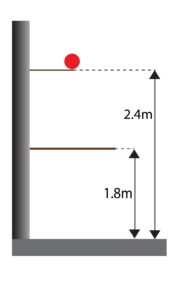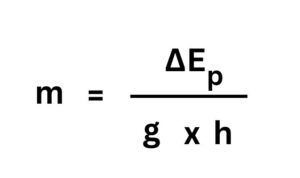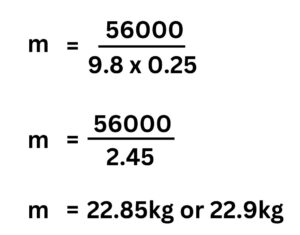Answers to GCSE Gravitational Potential Energy
Answers to Practice Questions
Practice questions (assume g to be 9.8N/kg on Earth)
1. A 1.5kg book is placed on a shelf 2.5m from the ground. Calculate the gravitational potential energy of the book.
ΔEp = m x g x h
ΔEp = 1.5 x 9.8 x 2.5 = 36.75J
or 36.8J (to 3SF)
2. A tennis ball of mass 200g is resting on a table 1.25m from the ground. Calculate the gravitational potential energy of the tennis ball.
Convert the 200g into kg, so this is 200g = 0.2kg
ΔEp = m x g x h
ΔEp = 0.2 x 9.8 x 1.25m = 2.45J
or 2.5J to (2 SF)
3. Use the image below to answer the following question.

The ball of mass 0.5kg falls from the higher shelf to the lower shelf.
Calculate the change in gravitational potential energy when the ball falls.
The ball is falling from the upper shelf to the lower shelf. This is a total distance of
2.4m – 1.8m = 0.6m
ΔEp = m x g x h
ΔEp = 0.5 x 9.8 x 0.6 = 2.94 J
or 2.9J
4. When a rock is thrown upards at its maximum height it has a gravitational potential energy of 56kJ and it is 250cm above the ground. Calculate the mass of the rock.
We need to convert the kJ to J, and the cm to m.
56kJ = 56000J, 250cm = 0.25m
ΔEp = m x g x h
Rearrange to make mass the subject of the equation


Absorption and Emission of EM Radiation
JJ Thomson and Plum pudding model
Ernest Rutherford and the Nuclear Model
Niels Bohr changing the Nuclear Model
Discovering the Proton and Neutron
Measuring radiation from radioactivity
Radiation types and properties
Random nature of radioactive decay
Radioactive contamination or irradiation
Hazards of contamination and irradiation
Studies on the effects of radiation on humans
Different half lives of radioactive isotopes
Nuclear Fission Chain Reaction
Writing nuclear fission equations